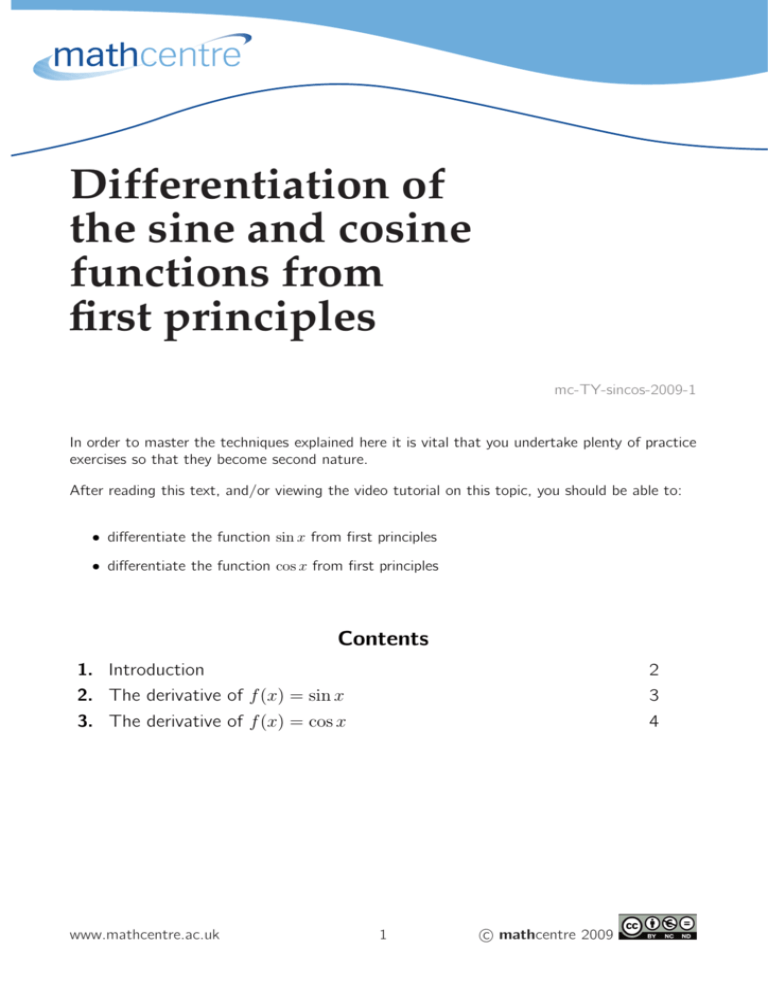Differentiation of the sine and cosine functions from
advertisement

Differentiation of the sine and cosine functions from first principles mc-TY-sincos-2009-1 In order to master the techniques explained here it is vital that you undertake plenty of practice exercises so that they become second nature. After reading this text, and/or viewing the video tutorial on this topic, you should be able to: • differentiate the function sin x from first principles • differentiate the function cos x from first principles Contents 1. Introduction 2 2. The derivative of f (x) = sin x 3 3. The derivative of f (x) = cos x 4 www.mathcentre.ac.uk 1 c mathcentre 2009 1. Introduction In this unit we look at how to differentiate the functions f (x) = sin x and f (x) = cos x from first principles. We need to remind ourselves of some familiar results. The derivative of f (x). The definition of the derivative of a function y = f (x) is f (x + δx) − f (x) dy = lim dx δx→0 δx Two trigonometric identities. We will make use of the trigonometric identities C +D C−D sin 2 2 C −D C +D sin cos C − cos D = −2 sin 2 2 sin C − sin D = 2 cos The limit of the function sin θ . θ As θ (measured in radians) approaches zero, the function sin θ tends to 1. We write this as θ sin θ =1 θ→0 θ lim This result can be justified by choosing values of θ closer and closer to zero and examining the sin θ behaviour of . θ sin θ Table 1 shows values of θ and as θ becomes smaller. θ θ 1 0.1 0.01 sin θ 0.84147 0.09983 0.00999 Table 1: The value of sin θ θ sin θ θ 0.84147 0.99833 0.99983 as θ tends to zero is 1. You should verify these results with your calculator to appreciate that the value of proaches 1 as θ tends to zero. We now use these results in order to differentiate f (x) = sin x from first principles. www.mathcentre.ac.uk 2 c mathcentre 2009 sin θ apθ 2. Differentiating f (x) = sin x Here f (x) = sin x so that f (x + δx) = sin(x + δx). So f (x + δx) − f (x) = sin(x + δx) − sin x The right hand side is the difference of two sine terms. We use the first trigonometric identity (above) to write this in an alternative form. sin(x + δx) − sin x = 2 cos = 2 cos x + δx + x δx sin 2 2 2x + δx δx sin 2 2 = 2 cos(x + δx δx ) sin 2 2 Then, using the definition of the derivative dy = dx f (x + δx) − f (x) δx→0 δx lim 2 cos(x + δx ) sin δx 2 2 = δx The factor of 2 can be moved into the denominator as follows, in order to write this in an alternative form: cos(x + δx ) sin δx dy 2 2 = dx δx/2 δx sin δx 2 = cos x + δx 2 2 We now let δx tend to zero. Consider the term θ= sin δx 2 δx 2 and use the result that lim θ→0 sin θ = 1 with θ δx . We see that 2 lim δx→0 sin δx 2 δx 2 =1 Further, δx lim cos x + δx→0 2 = cos x So finally, dy = cos x dx www.mathcentre.ac.uk 3 c mathcentre 2009 3. The derivative of f (x) = cos x. Here f (x) = cos x so that f (x + δx) = cos(x + δx). So f (x + δx) − f (x) = cos(x + δx) − cos x The right hand side is the difference of two cosine terms. This time we use the trigonometric identity C +D C −D cos C − cos D = −2 sin sin 2 2 to write this in an alternative form. cos(x + δx) − cos x = −2 sin −2 sin x + δx + x δx sin 2 2 2x + δx δx sin 2 2 = −2 sin(x + δx δx ) sin 2 2 Then, using the definition of the derivative dy = dx f (x + δx) − f (x) δx→0 δx lim −2 sin(x + δx ) sin δx 2 2 = δx The factor of 2 can be moved as before, in order to write this in an alternative form: ) sin δx sin(x + δx dy 2 2 = − dx δx/2 δx sin δx 2 = − sin x + δx 2 2 We now want to let δx tend to zero. As before lim δx→0 Further, sin δx 2 δx 2 δx lim − sin x + δx→0 2 =1 = − sin x So finally, dy = − sin x dx So, we have used differentiation from first principles to find the derivatives of the functions sin x and cos x. www.mathcentre.ac.uk 4 c mathcentre 2009







